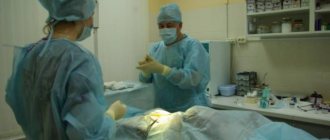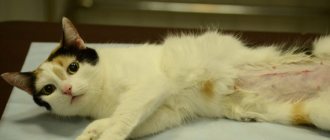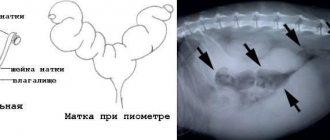Cat yells after sterilization - norm and deviations
If sterilization has been done, and the pet screams and asks to go outside in search of the cat, you should not blame the veterinarian for a poorly performed procedure. It is necessary to understand how the sterilization was carried out.
Many people mistakenly believe that spaying involves removing a cat's internal reproductive organs, but this is not true. The operation involves tying the fallopian tubes. As a result of surgical intervention, the animal does not lose its natural instincts to reproduce. The cat can mate, but does not have the ability to reproduce.
If the uterus and ovaries were removed during the operation, then this procedure is called castration. After its completion, the animal becomes infertile. The pet's sex drive disappears.
But if the animal was calm before the operation and never screamed, there is a possibility of developing a postoperative complication.
Can a cat ask for a cat after sterilization? Main reasons
The reason that a cat asks for a cat after sterilization may be an ill-chosen method, a poorly performed operation, or the production of sex hormones by other endocrine glands.
When contacting a veterinary clinic for the purpose of sterilization, you should find out exactly what method and method the operation will be performed. Without receiving a specific answer to this question, you should refrain from using the services of this establishment.
This information plays a key role when it becomes necessary to find out the cause of the condition when the female continues to ask for a cat after the removal of the reproductive organs.
Tubal occlusion
Tubal ligation, which deprives a cat of the ability to reproduce, is recognized as an inappropriate and inhumane method of sterilization. This is because the remaining ovaries continue to produce hormones that cause estrus and all the symptoms associated with it.
Having agreed to such an operation, the owners must be prepared for the fact that the female will periodically continue to mark corners, scream heart-rendingly, try to escape from the house and refuse food.
Hysterectomy
An equally barbaric method of sterilization is to remove only the uterus and preserve the ovaries, after which all signs of sexual heat continue to appear.
Previously, this method was used in cases of pathological childbirth, when prolapse of the uterus or a violation of its integrity was observed. The indication for hysterectomy was also purulent inflammation of this organ (pyometra). Currently, doctors agree that removal of the uterus must necessarily be accompanied by excision of the ovaries.
Ovariectomy
Spaying and leaving the uterus is only used in young nulliparous cats. The female does not exhibit sexual instincts, but the possibility of cancerous degeneration of the tissues of the remaining reproductive organs remains.
Excision of the ovaries and uterus is the most popular method of sterilization. It allows you to eliminate the symptoms of estrus and minimize the formation of malignant neoplasms of the mammary glands.
If an ovariohysterectomy was performed before her first heat, then there is virtually no risk that she will develop sexual instincts.
In rare cases, this behavior may be caused by the development of dangerous pathologies, which can only be determined by a veterinary medicine specialist after additional research.
There is such a thing as “ovarioreminant syndrome,” which means that after surgery a part of the ovary remains in the abdominal cavity. A feature of this organ is a high degree of regeneration. Even one cell, adhering to any internal organ, begins to multiply intensively and produce hormones.
This can be detected by conducting a laboratory blood test for the presence of gonadotropins, which stimulate the ovaries.
If this cannot be done using ultrasound due to the small size of the organ, then a diagnostic opening of the abdominal cavity is used with the simultaneous removal of residual tissue that secretes hormones.
Owners who are choosing the best age to sterilize a cat should know that in a female who has given birth, not only the ovaries, but also the adrenal glands, stimulated by the pituitary gland, are responsible for the production of sex hormones. Therefore, the preservation of sexual desire after surgery will continue.
Important! When sex hormones are released by the adrenal glands, estrus is permanent. This factor is taken into account when determining the reason why a cat continues to demand a cat after the removal of its reproductive organs.
This can be eliminated by a one-time administration of a hormonal drug. But you should not do this yourself, since it is necessary to accurately establish the cause of the appearance of signs of sexual heat. And this can only be done by a veterinarian after carrying out appropriate diagnostics.
If sterilization was carried out during the period of estrus, then the attenuation of hormonal levels will last from two to eight weeks. But such an operation is performed extremely rarely due to the risk of internal bleeding.
There is a congenital pathology called ectopic ovarian tissue syndrome, in which the cells of these organs are localized in unnatural places for them. In unsterilized cats, the disease goes unnoticed against the background of a general hormonal exacerbation during the period of estrus.
But after the operation it manifests itself as symptoms of sexual desire. Since treatment for the disease has not been developed, the cat will continue to suffer during the period of estrus, causing trouble to its owners.
Another reason that a cat requires a cat after castration is the presence in the body of a hormone-producing tumor of the adrenal glands, pituitary gland or mammary glands. In some cases, this condition is observed with polycystic uterus after oophorectomy.
Many cat owners, having noticed signs of heat in their cat after sterilization, immediately blame the veterinarian for this, stop trusting him and begin to solve the problem on their own. But, not knowing what to do, they begin to give hormonal or sedative drugs that provoke the occurrence of:
- pyometra;
- oncological neoplasms;
- mental disorders.
In addition, the use of such drugs without a correct diagnosis temporarily hides the symptoms of the disease and leads to the development of complications.
To alleviate the condition of the female and eliminate signs of estrus, you must adhere to the following rules:
- choose a sterilization method in which the ovaries and uterus are simultaneously removed;
- contact an experienced specialist;
- do not perform surgery during estrus;
- monitor the cat’s condition during the rehabilitation period in order to accurately describe alarming symptoms to the veterinarian;
- contact the clinic in a timely manner if the first signs of sexual heat occur.
You should not think that maintaining sexual desire when it is impossible to reproduce is a safe factor. In most cases, this ends in inflammatory processes and oncological growths of the tissues of the remaining reproductive organs and mammary glands.
If a cat screams after sterilization, the reasons can be very serious. This sometimes happens if doctors did not remove part of the ovary during surgery. The pet continues to feel physical attraction to males, but at the same time experiences considerable discomfort due to improper surgery performed on its reproductive system. In such cases, it is imperative to consult a doctor, since the cat will need a second operation.
If a cat yells after sterilization, this may be due to purely psychological reasons. In this way, the animal tries to attract the attention of others, force them to feed it or open the door. If the animal is always alone in a separate room, it can make heartbreaking screams due to the desire to communicate with people. In a similar way, the pet expresses its loneliness.
There is another reason for animal cries, which is sometimes difficult to believe. Some pets express anxiety in this way; they feel an approaching danger or natural disaster and try to communicate about it. There have been recorded cases where pets managed to predict a natural disaster and warn their owners about it by screaming.
There really can be many reasons, but most often the strange behavior of a pet indicates the development of some serious disease. For example, cats can scream very loudly at night due to the appearance of helminths. These parasites become active precisely at night, causing considerable discomfort to the animal.
Veterinarians advise not to use force if the cat screams day and night. If the pet owner constantly hits the animal or yells at it, this will not affect the situation in any way, but it will worsen the relationship between the obstinate cat and its owner.
Many people believe that neutered cats are calm and balanced and stop damaging wallpaper and furniture. But this is just a myth. Castration rarely changes the pet's character; often it continues to scream and scratch furniture. For the owners of an animal that they do not plan to let outside, this procedure for the fluffy will be the best option. Let's try to figure out why a castrated cat yells.
Furry pets, like people, have their own personalities. And this should be taken into account by every owner. If he is impulsive and talkative by nature, then the castration procedure will not instantly make him lazy and silent. Of course, some regularity in behavior will appear, but over time. This is due to a decrease in hormones that occurs gradually over a long period of time.
Representatives of some breeds are distinguished by phlegmatic tendencies, while others are pure sanguine. Behavior may change with age, especially after the procedure. But, if time passes, and a neutered cat constantly yells, damages furniture, and scratches, then you should think about it. Often the reason for this behavior may be stress or lack of attention on your part, and even signs of illness.
We suggest you read: How to use silica gel cat litter – is silica gel harmful to humans?
Sterilizing a cat is a complex operation, after which the animal can no longer have offspring. However, even after it is carried out, the pet may experience unusual reactions, for example, a cat may ask for a cat, disturbing its owners at night. This can happen for a number of reasons, depending both on the course of the operation and on the animal itself.
In quite rare cases, a sterilized female may go on a spree after sterilization. Usually this process frightens the owners and makes them wonder whether the operation was successful.
Similar cases are possible when the pet experiences hormonal imbalances, and then the cat begins to:
- stick out your butt;
- trample;
- shout loudly.
The presence of such symptoms clearly indicates that the cat is asking for a cat. In this case, it is necessary to consult a veterinarian so that he can accurately identify the cause of this behavior.
There are some reasons that may contribute to the continuation of estrus after sterilization.
And owners don’t always need to worry about this.
Poor operation
In the first 3 days after sterilization, the cat may have pain. This is not considered a pathology. To relieve symptoms, the veterinarian prescribes appropriate medications.
If sterility rules were not followed during surgery, infection may occur. The development of the inflammatory process will cause pain. Treatment is carried out using antibacterial therapy. In severe cases, surgery is required.
The cause of postoperative screams may be damage to internal organs. Regardless of whether the sterilization procedure was performed by the cavity or endoscopic method, there is a possibility of injury to adjacent tissues. This often happens if the surgery was performed by an insufficiently experienced specialist or due to the doctor’s negligence.
Reasons why a cat screams at night
To solve the problem of a cat yelling at night, you first need to understand the reason for its behavior. There are some pets that can vocalize around the clock, not only at night, but also in the morning. The most common reasons for such cat behavior are:
Hormonal surges
Cats that have not undergone sterilization regularly perform nightly concerts. Moreover, cats scream from such a strong desire to have offspring, which causes them physical and mental torment. A non-castrated cat experiences the same thing; when it screams, it tells its partner that it is full of strength and desire. It is impossible to combat this phenomenon in an animal that has not undergone sterilization. All that remains is to help the pet find its other half and wait out this difficult period.
We recommend reading: Rabies Vaccinations Help Dogs
Pet disease
- If an older cat, who seems to have survived the sterilization process, screams at night, then most likely she is tormented by some kind of disease. Often, when an old animal screams, it has diseases such as Alzheimer's or some kind of nervous disorder. This is an irreversible process, which can only be alleviated with the help of a veterinarian who has prescribed medications that can alleviate the pet’s condition at least temporarily.
- A similar reaction can be caused by acute abdominal pain, which can be determined by palpation. A healthy animal should have a soft belly that does not cause anxiety.
- If a previously calm cat screams restlessly, then it is quite possible that helminths are bothering him.
- When a neutered, middle-aged cat yells, this may be a sign of urolithiasis. The pain intensifies especially after visiting the toilet, therefore, at this time the animal will behave more restlessly.
- There are cases that after sterilization a cat screams and wants a cat. This is possible if part of the ovary was left behind during sterilization. Veterinarian consultation is required.
To attract attention
When a kitten screams at night, for no apparent reason, then perhaps he just wants to attract attention or beg for the desired treat. This tricky maneuver can be understood by treating the cat with a treat. When the reason lies in this, then the cunning person, after achieving his goal, will calm down. However, you cannot follow his lead, otherwise he will constantly terrorize the owner. Kitty, who is constantly alone, attracts attention to herself in this way; she also wants to communicate, play, and receive the necessary dose of affection.
Sense of anxiety
Cats are able to anticipate any unpleasant event or element; there have been cases when they predicted an earthquake in a similar way.
Battle for territory
Sometimes it is not enough for cats to place marks to claim their rights to the territory; they scream to declare their rights to a certain area. This is done to warn other cats so that they do not even think about entering into competition with him. Most often, a cat has to do this when moving to a new place of residence.
If a kitten screams, then this is a manifestation of longing for its mother cat. A kitten that has just appeared in the house behaves restlessly at first. You need to calm the baby down, talk to him kindly, then he will get used to it and everything will return to normal.
Hormones
Sterilization does not disrupt hormone production. For this reason, the cat may go into sexual heat. The instinct to reproduce does not disappear, so the animal may go into heat. It is accompanied by changes in the behavior of the pet.
A cat can be in heat even after spaying, because... The ability to produce the necessary hormones is retained by the adrenal glands and the pituitary gland. For this reason, the operation is recommended to be performed at 6 months, i.e. before the onset of the first sexual heat.
To normalize the state of health, the cat is prescribed hormonal medications.
Competent choice of sterilization method
Unfortunately, there are still cases where, due to the incompetence of veterinary specialists, a cat continues to experience the pangs of sexual desire even after sterilization. This happens if, instead of removing the ovaries, the doctor simply ties the fallopian tubes or removes only the uterus.
Sex hormones continue to be produced, but the female is unable to reproduce. These methods can be called not only inappropriate, but even inhumane.
It also happens that an inexperienced doctor removes only one ovary or leaves a small part of it, which continues to produce hormones. This can be determined using an ultrasound, but to correct it you will need a repeat operation.
Important! Before carrying out the operation, the veterinarian must clearly explain to the owners what method and method the reproductive organs will be removed. If this information is kept silent, then you should not use the services of this clinic.
Why does a cat scream as if she's in heat?
However, veterinarians are not always to blame for the fact that a cat meows after sterilization, demanding a male. Sometimes owners take too long to decide on the operation, missing the most optimal age, which is from 7 to 10 months, depending on the breed and individual characteristics of the female. During this period, the kitten has already formed all its organs and systems, but has not yet come into heat.
Some owners adhere to the outdated misconception that a cat must give birth once before being spayed. Modern research disproves this information, since after childbirth, the female begins to synthesize sex hormones in the adrenal glands and pituitary gland. Under their influence, the cat screams as if in heat, even after excision of the ovaries.
In this case, it is necessary to administer a hormonal drug, which is prescribed by a doctor after conducting the necessary studies.
What to do if the cat screams
If the reason for sterilization was the reluctance of the cat’s owners to decide what to do with the offspring, but they are not embarrassed by the screams that occur during estrus, then nothing needs to be done. In a situation where the animal’s behavior does not suit the owners, it is recommended to undergo complete castration.
Long-term use of hormonal drugs that suppress egg maturation can cause the development of additional health problems, so this method is not recommended by veterinarians.
Veterinarian advice
Some veterinarians consider it inappropriate to sterilize a cat, which involves tying the fallopian tubes. After the operation, the animal continues to lead its usual lifestyle, so there is still a possibility of developing other health problems characteristic of pets who have not undergone surgery:
- inflammation of the uterus and appendages;
- cystic endometrial hyperplasia;
- infections transmitted through sexual contact;
- benign and malignant neoplasms, etc.
Estrus in sterilized cats may last longer than in unoperated cats, because fertilization does not occur. The possibility of a false pregnancy cannot be ruled out. This process is caused by a violation of the animal’s neuropsychic state. If a false pregnancy occurs, the cat's life is at risk if treatment is not started in a timely manner. The animal begins to produce milk, which is dangerous for the development of mastitis. False pregnancy can occur repeatedly.
Before getting a female pet, you need to think in advance about all possible problems and difficulties that may arise in the future, including deciding on sterilization. If in doubt, it is best to consult a veterinarian.
All information posted on the site is provided in accordance with the User Agreement and is not a direct instruction to action. We strongly recommend that before using any product, you must obtain a face-to-face consultation at an accredited veterinary clinic.
Condition of the cat immediately after sterilization
The general condition and behavior of the cat after sterilization changes daily.
Day 1
On the first day after surgery, the cat has no appetite, lethargy, drowsiness, coordination of movements is impaired, hallucinations and disorientation may occur - the pet tries to run or crawl in an unknown direction, stops abruptly, runs into walls, falls and falls asleep, jumps up, etc. This behavior is normal and there is no reason to worry.
The cat may not blink, in which case it is necessary to close her eyes yourself until she starts blinking again, otherwise there is a risk of drying out the cornea.
In addition, involuntary urination and vomiting are possible.
On the first day after sterilization, you need to be close to your pet and monitor its condition. You cannot feed the animal, but only give it water from a syringe or pipette.
Day 2
During the second day, the cat begins to come to its senses, its behavior becomes more adequate. The pet has a desire to hide in dark, hard-to-reach places, so it is necessary to monitor it and constantly keep it in sight.
If a cat is in pain, it may try to bite someone who tries to touch it.
At this time, the animal shows a desire to lick the area near the incision and reacts too excitedly to all extraneous sounds.
On the second day, you can put water near the animal and start feeding it in small portions.
Day 3
On the third day, the cat fully comes to her senses: she is active, reacts with interest to what is happening around her, goes to the litter box and begins to ask for food.
You need to measure your pet’s body temperature twice and, if the readings are elevated or decreased, contact your veterinarian.
Due to the fact that anesthesia can slow down intestinal motility, it is necessary to monitor the regularity of bowel movements and, in the absence of bowel movements, you can give the cat mild laxatives.
Day 4
On the third day after sterilization, the cat should eat and drink independently, and should actively urinate and defecate.
Day 5
On the fifth day, the swelling and redness near the suture subsides, and scarring begins.
The cat is becoming more and more active and can now walk around the apartment.
And if before the operation the pet had access to the street, then into the yard, you can jump on low surfaces.
Day 6 and 7
By this time, the pet’s activity and appetite are completely restored, pain completely disappears, urination and bowel movements occur as usual.
The well-being of a cat after sterilization depends on several factors:
- age at the time of surgery;
- whether the procedure was planned or emergency;
- type of anesthesia used.
After recovering from anesthesia, the animal may experience pain, which usually goes away on the second day. The main signs of postoperative pain are:
- manifestation of aggression;
- dilated pupils;
- prolonged immobile stay in one position;
- gaze directed at one point;
- refusal to eat.
READ Dislocation of the hip joint in a cat causes diagnosis treatment
To alleviate the pet’s condition, you should give her a painkiller injection or give her an anesthetic drug orally.
Postoperative behavior depends on the individual characteristics of the cat, its psyche and stress tolerance.
After sterilization, some animals may consider themselves completely healthy, not feel any discomfort, continue to lead their usual lifestyle, or become hyperactive.
This behavior negatively affects the recovery process. Due to increased activity, a cat may bite, scratch, show aggression towards people or animals around it, and attack them.
It is better to prepare for this behavior of your pet in advance by equipping it in a cool, calm, isolated place. It is necessary to limit the animal’s movements, ensure complete rest, and you can add sedatives to the water.
Sterilization leads to the cessation of the production of sex hormones that reduce appetite, so in a sterilized cat it increases, metabolic processes slow down, as a result of which the pet’s body weight may increase.
It is necessary to control the amount of food your cat eats and feed it with specialized food often, but in small portions.
Display of aggression
Surgery and recovery from anesthesia are stressful for the animal. The cat is in pain and reacts overly excitedly to surrounding sounds, any noise and people around. All this affects behavior that may become uncharacteristic for her: the pet may hiss, growl, try to bite and show aggression.
Loud screams and aggressive behavior from a cat indicate that it is experiencing severe pain or nausea. If your pet screams for a long period of time, you need to contact a veterinarian who will examine her, determine her condition and, if necessary, prescribe painkillers.
Also, during the postoperative period, the cat may scream if an incomplete operation was performed - in this way the pet demonstrates character and asks the cat. In such a situation, the best solution is to perform a complete operation to completely eliminate the cat's sex drive.
In addition, a cat may scream in order to attract the attention of the owner.











